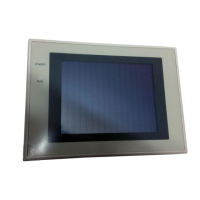15
Communication with the Host
Section 1-3
1-3 Communication with the Host
The NT31/NT31C is connected to the host by one of the following four commu-
nication methods.
S Host link method:
S NT link (1:1) method
S NT link (1:N) method
S Memory link method
In all of these communication methods that can be used with NT31/NT31C, data
communication with host is by ”direct connection” (Memory link is, however, a qua-
si--direct connection).
In the following, the host link and NT link that carry out the “direct connection” will
be discussed. Memory link will be explained in section “1--4 Communication by
memory link”.
1-3-1 Direct Connection Function
With the NT31/NT31C, the bits and words referring to data required for display,
and those for storing input data, can be allocated to any part of the PC memory
area.
The NT31/NT31C can directly write to and read from suchallocatedbits andwords
to changethe displaystatus of the elements on the PT screen, controlthePT oper-
ating status, and notify statuses to the host.
This function, which directly reads and writes the statuses of words and bits with-
out using a PC program is called the “direct connection” function.
The words and bits allocated for direct connection are called the “allocated words”
and “allocated bits”.
The direct connection function allows the data to be displayedat the NT31/NT31C
to be read from the memory area in the PC and written to memory tables in the
NT31/NT31C. Also, the data input at the NT31/NT31C can be written to the
memory area in the PC. The NT31/NT31C screen can be changed in accordance
with statuses in the PC memory area, and the NT31/NT31C’s status data can be
written to the PC’s memory area.
PCNT31/NT31C
DM area I/O relay area
Auxiliary relay area Timers/counters

